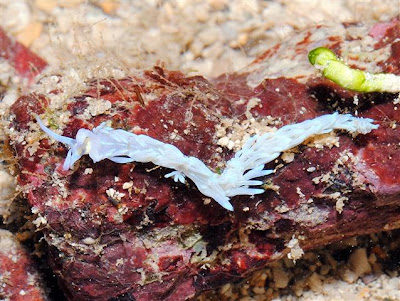We had a rain-free day at Pulau Jong this morning! And there were lots of beautiful sea slugs!
It has been a while I see so many slugs on a single trip... so be warn to see lots of them in this blog post haha. The first slug that I saw after landing on this island will be the Black-margined nudibranch (Glossodoris atromarginata).
The bloom of Hairy green seaweed (Bryopsis sp.) may seem to be a good thing as several kinds of slugs seem to inhabit among them. There were numerous Gymnodoris nudibranchs (Gymnodoris sp.) around and this seems to be the Gymnodoris citrina. The G. citrina has spiky edges especially near the head.
While this other Gymnodoris nudibranch does not seem to be that spiky by its edge. Since it is too small, identification would be difficult.
Another nudibranch found in great numbers will be this bluish Pimply phyllid nudibranch (Phyllidiella pustulosa).
Once in a blue moon, we will encounter the pink version of the same type of phyllid nudibranch. I think this colour is more endearing, don't you agree? :)
Looking similar to the above nudibranch since they belong to the same genus, this slug with purplish bumps is actually the Black phyllid nudibranch (Phyllidiella nigra). They belong to the same genus.
This Bohol nudibranch (Discodoris boholiensis) was actually found on top of the hairy seaweed!
Here's another one found near to the previous Bohol nudibranch.
A Blue dragon nudibranch (Pteraeolidia ianthina) was spotted! However, it looked "bleached", without its bluish coloration. Chay Hoon later told me this is because the slug has not been feeding on hydroids recently.
Ria found two slugs, one of which is this tiny unknown one in orangey yellow. It could be a Dendrodoris slug.
The other slug that she found was the Starry mouthed nudibranch (Bornella stellifer). Many tiny Polka-dot nudibranch (Jorunna funebris) were sight as well.
More slugs among seaweed! This is the Tiny armina nudibranch (Dermatobranchus sp.) with lines along the body of the slug.
Last but not least, for the slug-ful finds, this pair of tiny slugs are probably the Woolly leaf slugs (Elysia cf. verrucosa).
Now let's move on to the flatworms! Also abundant on the shores and probably on season are many of these Blue-lined flatworm (Pseudoceros sp.). It has one blue stripe along the length of the body. The line ends with a little blue circle-dot near the head.
Flatworms have a pair of erect pseudotentacles at the front made up of folded edges of the body which can sense light.
It has been a while since I've seen this Three stripe flatworm (Pseudoceros tristriatus). It is among one of the prettier flatworms in Singapore. This flatworm was quite active though moving up and down on the rock.
So much so that I missed this maroon Chiton (Class Polyplacophora) that clung onto the rock tenaciously. I only saw it while processing photos back at home!
More urchins! But dead ones though.... Two dead skeletons or tests of the Oval maretia heart urchin (Maretia ovata) were found. They could have been recently predated upon. Otherwise, these heart urchins tend not to be seen as they are usually buried under the sand.
I went right out to the reef edge during the lowest possible tide and was glad to know that the Magnificent anemone (Heteractis magnifica) is still there.
I later also saw this brown and green Magnificent anemone, though this was high and dry on top of a rock boulder exposed during low tide.
There were also several Giant carpet anemones (Stichodactyla gigantea).
Probably a new record for Jong, this anemone with long tentacles is likely to be the Leathery sea anemone (Heteractis crispa)!
I was flipping rocks to check what lies underneath and came across two tiny and skinny spider crabs. Here is a test of your observation skills... can you spot the two of them in this photo? It is not easy!
There are some good growth of corals on the reefs of Pulau Jong though not as fantastic as some of the other southern reefs. This photo shows the Blue corals (Heliopora coerulea) with Semakau landfill on the left and Bukom on the right as backdrop.
You can find more blue corals in the upper part of the photo and a colony of an uncommon hard coral in green.
That green coral mentioned earlier is actually the Pebble coral (Astreopora sp.).
The Horn coral (Hydnophora sp.) is one with conical bumps and is also not commonly seen on our reefs.
The only mushroom coral that I came across will be this Mole mushroom coral (Polyphyllia sp.).
Though the hard corals of Singapore are not as well represented and abundant in Jong, this shore is more known of its soft corals! The colonies of soft corals here are large and plentiful. Here's a photo showing the soft corals with Pulau Sebarok at the background.
Last but not least, to end off the post, here's a landscape shot of the Jong island with the Leathery soft corals (Family Alcyoniidae) and the resident Fluted giant clam (Tridacna squamosa), which we are so relieved to see that it is still there.
Here's a closer look at the giant clam that we first took notice of since 2008. It used to be surrounded by a lot more leathery soft coral in the past.
That's all for my adventures this low tide season! Time to catch up with sleep and other stuffs! :)



































1 comment:
Your photos are really nice. Shows a different side of Singapore.
Post a Comment